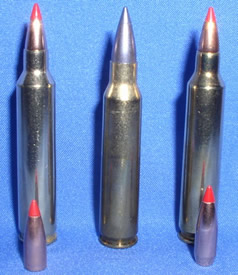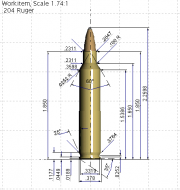.204 Ruger
| .204 Ruger Cartridge | .204 Ruger Ballistics tables | Cartridges |
| .204 Ruger | ||||||||||||||||
|---|---|---|---|---|---|---|---|---|---|---|---|---|---|---|---|---|

| ||||||||||||||||
| 204 Ruger 32 grain (2.1 g) Vmax, 223 Remington 55 grain (3.6 g) Vmax, 204 Ruger 40 grain (2.6 g) Vmax. | ||||||||||||||||
| Type | Rifle | |||||||||||||||
| Country of Origin | United States | |||||||||||||||
| Specifications | ||||||||||||||||
| Parent Case | .222 Remington Magnum | |||||||||||||||
| Case Type | Rimless, bottleneck | |||||||||||||||
| Bullet Ø | .204 in (5.2 mm) | |||||||||||||||
| Neck Ø | .2311 in (5.87 mm) | |||||||||||||||
| Shoulder Ø | .252 in (6.4 mm) | |||||||||||||||
| Base Ø | .3764 in (9.56 mm) | |||||||||||||||
| Rim Ø | .378 in (9.6 mm) | |||||||||||||||
| Rim Thickness | .0449 in (1.14 mm) | |||||||||||||||
| Case Length | 1.850 in (47.0 mm) | |||||||||||||||
| Full Length | 2.2598 in (57.40 mm) | |||||||||||||||
| Rifling twist | 1-12 | |||||||||||||||
| Primer | small rifle | |||||||||||||||
| Production & Service | ||||||||||||||||
| Designer | Ruger/Hornady | |||||||||||||||
| Design Date | 2004 | |||||||||||||||
| Production Dates | 2004-Present | |||||||||||||||
| Ballistic Performance Sampling | ||||||||||||||||
| ||||||||||||||||
Contents |
[edit] Characteristics

[edit] Development
The .204 Ruger was the second Ruger-named cartridge produced by a partnership between Ruger and Hornady, the first being the big bore .480 Ruger revolver cartridge, introduced in 2003 for the Super Redhawk. With the backing of a major gunmaker and a major ammunition company, the round was an instant success, with other ammunition makers and firearms makers quickly producing offerings in the new caliber. Ruger's initial offerings included the bolt action Model 77 MKII, and the single shot Ruger #1, and Hornady offered loadings with 32 and 40-grain (2.6 g) bullets.
The .204 Ruger is proving to be a very accurate and efficient cartridge: an early tester reported 1/2 MOA groups at 100 yards (91 m) with the Hornady loads and a Ruger #1 Varmint rifle. This is not surprising, considering that the first cartridge in the family, the .222 Remington, was a top benchrest shooting cartridge for many years after its introduction.
The .204 Ruger was intended primarily for varmint rifles, which require bullets with flat trajectories but not much mass or kinetic energy. The .20 was "splitting the difference" between the popular .22 varmint rounds such as the .220 Swift and .22-250 Remington, and the tiny .17 caliber rounds such as the .17 Remington and the .17 HMR. The resulting cartridge provides somewhat higher velocities than any of these, giving a maximum point blank range of more than 270 yards (248 m).
[edit] Velocity
Ruger's claim to velocity king with the .204 was based on two points. First, that other 4000+ ft/s cartridges were wildcats, not commercially produced; the 5mm/35 SMc, for example, can reach 4,800 ft/s (1,500 m/s) using a 30-grain (1.9 g) bullet.
Second, the ammunition used to achieve the 4200+ ft/s was only available from Hornady using a special powder not available to the general public [2]. Handloaders typically achieve velocities more in the area of 4,050 ft/s (1,230 m/s) using a 32-grain (2.1 g) bullet.[3]. Note that handloads using a 40-grain (2.6 g) bullet in other commercial cartridges such as the .220 Swift and .223 WSSM also achieve similar velocities to the .204 Ruger. The advantage of the .20 caliber .204 is that it achieves these velocities using less powder, less recoil, and less heat than the heavier cartridges. The 204 Ruger has a maximum range of approximately 500 yards (460 m).
One of the down-sides to firing bullets at such velocities is short barrel life. Generally speaking, extremely fast bullets tend to wear out a barrel significantly sooner than slower ones. The high pressures, temperatures, and friction can quickly wear away portions of the throat and rifling. This erosion results in deteriorating accuracy. The amount of erosion and time it takes to negatively affect accuracy is based on things like temperature [4], bore-size, velocity, etc. This effect is common to all small arms cartridges that approach or exceed muzzle velocities of 4,000 ft/s (1,200 m/s), including the .17 Remington, .220 Swift, and .22-250 Remington.
[edit] See also
[edit] References
- ↑ Hornady
- ↑ .204 Ruger by Chuck Hawks
- ↑ .204 load data at Hodgdon
- ↑ Barrel Heating at Superior ballistics
- Cartridge Dimensions from 6mmBR.com
- Guns Magazine, 2004
- GunBlast.com, May 2004
[edit] External links
- .204 Ruger info at Hornady website
- Sturm, Ruger & Co., Inc.
- 204 Ruger info at www.204ruger.com